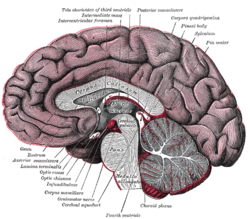Septum pellucidum
| Septum pellucidum | |
|---|---|

Scheme of rhinencephalon (septum pellucidum visible at top center)
|
|

Median sagittal section of brain (septum pellucidum visible at center)
|
|
| Details | |
| Identifiers | |
| Latin | Septum pellucidum (lamina septi pellucidi) |
| MeSH | A08.186.211.276.814 |
| NeuroNames | hier-238 |
| NeuroLex ID | Septum pellucidum |
| TA | A14.1.09.262 |
| FMA | 61844 |
|
Anatomical terms of neuroanatomy
[]
|
|
The septum pellucidum (translucent hedge) is a thin, triangular, vertical double membrane separating the anterior horns of the left and right lateral ventricles of the brain. It runs as a sheet from the corpus callosum down to the fornix.
The septum pellucidum is located in the midline of the brain, between the two cerebral hemispheres. It is attached superiorly to the corpus callosum, the large collection of nerve fibers that connect the two cerebral hemispheres. It is attached inferiorly to the anterior part of the fornix, and on either side of the septum are the two lateral ventricles.
The septum pellucidum consists of two layers or laminae of both white and gray matter. During fetal development there is a space between the two laminae called the cave of septum pellucidum which, in ninety per cent of cases, disappears during infancy. The cavum is occasionally referred to as the fifth ventricle but the term has lost favor in recent years, as the space is usually not continuous with the ventricular system. Indeed, fifth ventricle has been used for other purposes in recent years.
The septum pellucidum is often confused with the septal nuclei. Logically, the septum pellucidum is a septum in the medial plane and could therefore be termed 'medial septum', but this is incorrect. The term medial septum is reserved for a small group of nuclei which are closely associated with the septum pellucidum.
Absence of the septum pellucidum occurs in septo-optic dysplasia, a rare developmental disorder also characterized by abnormal development of the optic disk and pituitary deficiencies. Symptoms of septo-optic dysplasia are highly variable and may include vision difficulties, low muscle tone, hormonal problems, seizures, intellectual problems, and jaundice at birth. Children born without any other cognitive issues, other than an absent septum pellucidum, usually progress through life normally, and usually have no learning or cognitive disabilities.
...
Wikipedia
